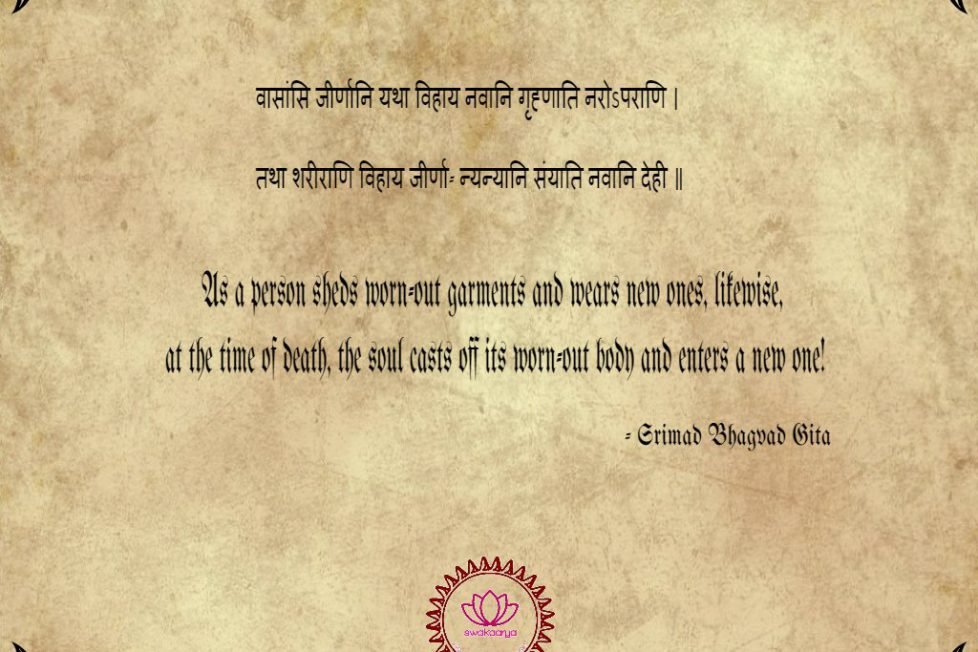Concept of Rebirth – Bhagvad Gita & the support of (Baby)Science – a Reiteration of the ancient Indian wisdom


The basis or purpose of the ancient Indian systems / culture for an individual is to enjoy and fulfill all the desires while living on planet earth and, finally, to attain “freedom” for the soul i.e. no rebirth. This can happen only when there are no desires left. There is no intervention from anyone except the mind. It is all made up by the conscience of an individual only.
An example of the immortal wisdom of our ancestors is preserved in the Bhagvad Gita, part of the Mahabharatha, an ancient Indian epic.
Verse 22 of Chapter-2 of the Bhagvad Gita:
वासांसि जीर्णानि यथा विहाय नवानि गृह्णाति नरोऽपराणि ।
तथा शरीराणि विहाय जीर्णा- न्यन्यानि संयाति नवानि देही ॥
vasansi jirnani yatha vihaya navani grihnati naro ‘parani
tatha sarirani vihaya jirna nyanyani samyati navani dehi
Meaning:
As a person puts on new garments, giving up old ones, similarly, the soul accepts new material bodies, giving up the old and useless ones.
Alternatively:
As a person sheds worn-out garments and wears new ones, likewise, at the time of death, the soul casts off its worn-out body and enters a new one.
So, when we read this, doesn’t our “BIG” “SCIENTIFIC” mind asks – oh what nonsense is this “REBIRTH”; where is the proof. Well…please read on….
https://med.virginia.edu/perceptual-studies/wp-content/uploads/sites/360/2015/11/jse-22-1-2008.pdf
Dr. Ian Stevenson established the Division of Personality Studies(renamed as Perceptual Studies) in order to conduct research in which scientific methodology is utilized to empirically investigate phenomena which cannot be explained by the currently accepted scientific assumptions and theories about the nature of mind or consciousness, and its relationship to matter.
Here is an excerpt about Dr.Ian Stevenson from the Journal of Scientific Exploration-Vol.22-Number 1, 2008.
“For Ian, his academic life was focused fervently on expanding the frontiers of knowledge and wisdom and on understanding the human condition and its never-ending travails. Not for him were the small questions, the orthodox problems, or popular issues. Perhaps he was influenced by Alan Gregg, the famed vice-president of the Rockefeller Foundation, whose funding jump-started the biomedical era. Gregg used to remark repeatedly that ‘‘if you are going to do research, you should tackle important problems. For me,’’ he said, ‘‘the most important problem is whether there is a life hereafter, but there aren’t many people pursuing such matters!’’
Encouraged and funded by Eileen Garrett, a famous and well-documented English medium, later based in New York, Ian traveled to India in 1961 to investigate his first case, that of a young child’s account about an earlier life or of possible reincarnation. Chester Carlson—inventor of Xerox—provided funds for further research travels by Ian and eventually endowed a chair for him at the University of Virginia. This largesse enabled Ian to give up his departmental administrative duties and establish the Division of Personality Studies (currently labeled the Division of Perceptual Studies). Shunned by most of his academic colleagues but courageously supported by Dean Thomas Hunter—a believer in freedom of enquiry in Mr. Jefferson’s ‘‘academical village’’—Ian persisted.
For 45 years Ian and his colleagues, as well as a global cadre of ‘‘scouts’’ and interpreters, have amassed reports of almost 3,000 individuals who recounted memories of places, experiences, events, circumstances, and individuals for which, as he usually put it, ‘‘reincarnation is not the only explanation we have, but it is the best explanation we have for the strongest cases.’’ Several documentary films, countless interviews, 15 books, and several hundred articles recount in exquisite detail his case reports, observations, experiences, and interpretations. The raw data are available at the University of Virginia for others to examine and draw their own conclusions. A long-time friend of Ian’s, the late Dr. Harold Lief, once remarked that Ian’s insights might one day be likened to those of Galileo. To Ian’s ever-enduring disappointment, few in today’s orthodox medical establishment would even examine his data, to say nothing of embracing his conclusions. As he wrote in Harper’s Magazine, all those many years ago, there still are far too many Western ‘‘Scientists with Half-Closed Minds.’’
THANK YOU Dr.Ian Stevenson…YOU LIVE THROUGH YOUR WORK…WE need many more doctors like you for reassuring our present generation of the “immortal wisdom” present in our ancient systems.
So…what shall we conclude…that our ancestors were roaming around naked with leaves tied around them and that we evolved from monkeys…well…IT’S UPTO YOU TO DECIDE…
DISCLAIMER: The author is solely responsible for the views expressed in this article. The author carries the responsibility for citing and/or licensing of images utilized within the text.
